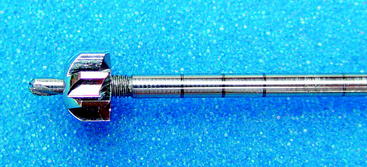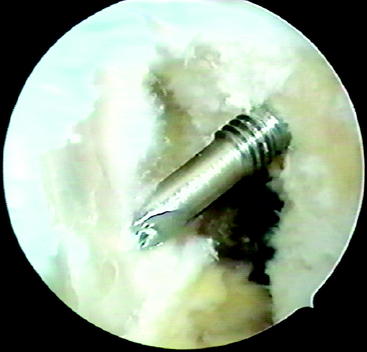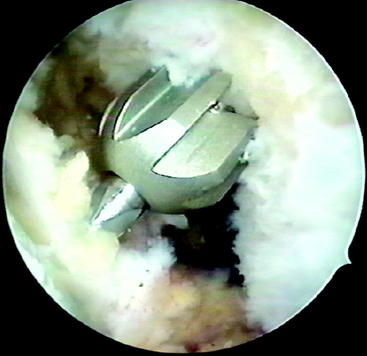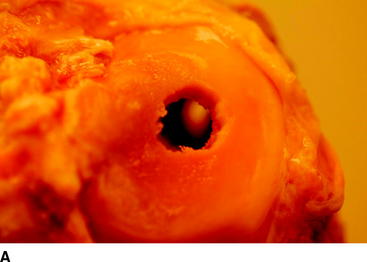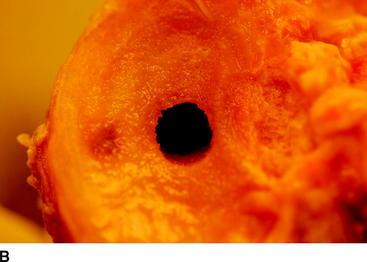Chapter 20 The Retrodrill Technique for Anterior Cruciate Ligament Reconstruction
Introduction
Arthroscopic controlled retrograde drilling of femoral and tibial sockets and tunnels using a specially designed cannulated drill pin and retrocutter (Fig. 20-1) provides greater flexibility for anatomical graft placement and avoids previous tunnels and intraosseous hardware in revision cases. Inside-out drilling of femoral and tibial sockets minimizes incisions and eliminates intraarticular cortical bone fragmentation of tunnel rims common to conventional antegrade methods. This technique is also ideal for skeletally immature patients because drilling and graft fixation through growth plates may be avoided. Initial tunnel positioning (and not referencing) for cannulated drill guide pin placement is carried out from outside-in. This technique (outside-in/inside-out) combines the advantages of the two-incision and one-incision techniques. In fact, it permits surgeons, as with the two-incision technique, to drill a pin guide from outside to inside in order to obtain the correct anatomical insertion of the anterior cruciate ligament (ACL) (Fig. 20-2), which is otherwise not reproducible from inside-out.
This technique permits the surgeon to prepare a femoral and a tibial socket or tunnel by initiating the socket drilling from the intraarticular surfaces in an inside-out method (Fig. 20-3). Since November 2004, our preferred technique for hamstring (autogenous quadrupled semitendinosus/gracilis) ACL reconstruction incorporates the just-mentioned femoral socket creation. In recent years, arthroscopically assisted ACL reconstruction has become the procedure of choice. Initially, arthroscopic techniques required two incisions for outside-in drilling of bone tunnels, but there has been a trend toward using a single incision with inside-out drilling of the femoral tunnel. Those who advocate the two-incision technique state that they do so primarily because they believe that the two-incision procedure facilitates accurate femoral tunnel placement.1,2 Harner et al3 found no difference in tunnel placement using the two-incision technique, whereas Schiavone et al4 found that the femoral tunnels were significantly more vertical in the one-incision procedure. We have performed two-incision ACL reconstruction routinely since 1977 with very favorable results. The recent variation in our technique affords a reduction in morbidity associated with improved cosmesis and quicker postoperative recovery. A factor related to our success appears to be the result of a more anatomically positioned femoral tunnel, which in our hands is difficult to accomplish with single-incision transtibial femoral socket creation. Arnold et al,1 who examined the arthroscopic appearance of the ACL attachment in fresh frozen cadaver knees, found that the ligament consistently inserted on the lateral wall of the notch. No fibers were found to attach high in the roof. Furthermore, they found that the single-incision technique always missed the anatomical femoral ACL insertion. Another advantage of the retrodrill is that the traditional (outside-in) drilling methods disrupt the proximal tibial cortex with the drill penetration and may lead to tunnel widening. Retrodrilling produces a consistently smooth tibial and femoral intraarticular socket or tunnel entrance, maintaining the desired cortical integrity (Fig. 20-4).
Femoral Tunnel Placement
Over the past several decades, bioengineers and orthopaedic surgeons have applied the principles of biomechanics to gain valuable information about the tunnel placement in ACL reconstruction and its relationship to knee stability. Still, both short- and long-term clinical outcomes studies have revealed that 11% to 32% of the patients experience unsatisfactory results after ACL reconstruction.5 The position of an ACL graft is the most critical surgical variable because it has a direct effect on knee biomechanics and, ultimately, on clinical outcome. Currently, limited data are available from prospective studies that identify the optimal intraarticular position of an ACL graft on the femur and tibia. A recent review of the literature by Beynnon et al6
Stay updated, free articles. Join our Telegram channel

Full access? Get Clinical Tree


